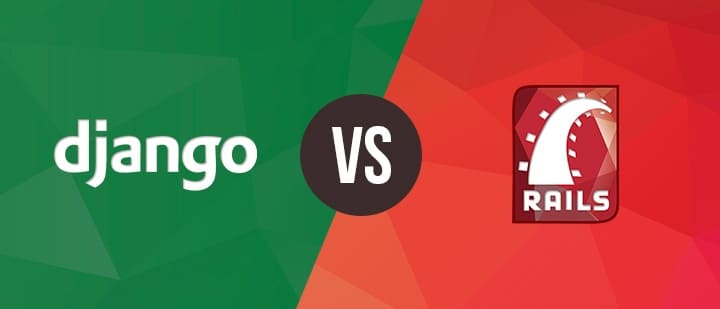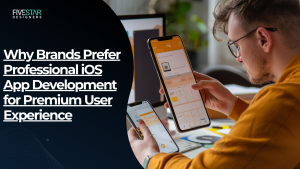In the ever-evolving world of web development, choosing the right framework is crucial for building robust and efficient applications. Two popular frameworks that often come up in discussions are Django and Ruby on Rails. In this blog, we will provide a detailed comparison of Django vs Ruby on Rails to help you decide which framework suits your web development needs in 2023.
Read more about: How to Choose an App Development Company
What is Django?
Django is a high-level Python web framework known for its simplicity, versatility, and emphasis on rapid development. It follows the Model-View-Controller (MVC) architectural pattern and emphasizes the DRY (Don’t Repeat Yourself) principle. Django offers a wide range of built-in features and libraries that facilitate rapid development and scalability. It provides an excellent foundation for building complex, data-driven applications.
What is Ruby on Rails?
Ruby on Rails, commonly referred to as Rails, is a full-stack web development framework written in Ruby. Rails is designed to promote convention over configuration, enabling developers to focus on writing code rather than dealing with complex configurations. It emphasizes convention-based development and follows the MVC architectural pattern. Rails is known for its elegance, efficiency, and emphasis on rapid development, making it a popular choice for startups and small-to-medium-sized businesses.
Django vs Ruby on Rails Frameworks: What is the Difference?
Language
Django is built using Python, a widely adopted and versatile programming language known for its readability and extensive libraries. Python’s syntax is clean and easy to understand, making it an excellent choice for developers of all skill levels. Python’s extensive standard library and third-party packages contribute to Django’s rich ecosystem. On the other hand, Ruby on Rails is built using Ruby, which is renowned for its elegant syntax and expressive code. Ruby’s syntax is often considered more concise and human-readable, allowing developers to write code that is easy to understand and maintain.
Architecture
Both Django and Ruby on Rails follow the MVC architectural pattern. However, Django’s architecture is more flexible and allows developers to choose between using traditional MVC or the MTV (Model-Template-View) approach. Django separates the business logic (Model), user interface (Template), and request/response handling (View) components. This flexibility allows for better customization and adaptability to project requirements. Ruby on Rails adheres strictly to the MVC pattern, providing a clear separation between the Model (database and business logic), View (user interface), and Controller (handles requests and orchestrates the flow). This strict adherence simplifies development by enforcing a clear structure and reducing the need for explicit configuration.
Popularity
In terms of popularity, Django and Ruby on Rails both have substantial user bases and active communities. Django has gained significant traction due to its widespread adoption by large organizations such as Instagram, Pinterest, and Disqus. The Python community’s contributions to Django’s ecosystem, including numerous packages and libraries, have further fueled its popularity. Ruby on Rails, while not as widely adopted as Django, continues to be popular among startups and small-to-medium-sized businesses due to its emphasis on rapid development, convention-based workflows, and the vibrant Ruby community. The popularity of both frameworks ensures ongoing development, support, and a wealth of resources.
User Interface
Django provides a feature-rich administrative interface, known as the Django Admin, which enables developers to manage the application’s data models easily. The Django Admin is automatically generated based on the application’s models and allows for convenient CRUD (Create, Read, Update, Delete) operations without writing additional code. The Django Admin interface is highly customizable, making it suitable for building content management systems and administrative backends. Ruby on Rails includes scaffolding tools that generate code and a basic user interface automatically, saving time during initialdevelopment. However, Rails’ scaffolding is often considered less feature-rich compared to Django’s Admin interface. Rails developers typically rely on additional gems or custom development to create robust user interfaces tailored to their application’s specific needs.
Speed & Performance
Both Django and Ruby on Rails are performant frameworks, but their performance characteristics can vary based on the specific application and its requirements. Django’s use of Python, a dynamically-typed language, can lead to slightly slower execution times compared to Ruby on Rails, which uses Ruby, a dynamically-typed language. However, the performance difference between the two frameworks is generally negligible and can be further optimized by leveraging caching mechanisms, database optimizations, and other performance-enhancing techniques.
Stability
Stability is a crucial factor when selecting a web development framework. Django has a long-standing presence in the market, with its initial release dating back to 2005. The framework has evolved and matured over the years, garnering trust from developers worldwide. Ruby on Rails, despite being slightly older, has a strong track record of stability and reliability. The Rails community actively maintains and updates the framework, ensuring its stability and compatibility with the latest technologies.
Installation
Installing Django and Ruby on Rails is relatively straightforward. Django can be installed using the pip package manager, which is the standard package manager for Python. The official Django documentation provides step-by-step instructions for installation on various operating systems. Ruby on Rails can be installed through the RubyGems package manager, which is the default package manager for Ruby. The installation process typically involves installing Ruby, followed by the installation of the Rails gem. The Ruby on Rails website offers detailed installation guides for different platforms.
Security
Both Django and Ruby on Rails prioritize security and provide mechanisms to mitigate common web vulnerabilities. Django, by default, provides protection against common web vulnerabilities such as cross-site scripting (XSS) and cross-site request forgery (CSRF). Django’s security features include automatic HTML escaping, secure session management, and protection against SQL injection attacks. Ruby on Rails employs security features like parameter sanitization, protection against SQL injection attacks, and built-in protection against common vulnerabilities.
Scalability
Django and Ruby on Rails are both scalable frameworks that can handle high traffic and large-scale applications. Django’s scalability is achieved through its support for horizontal scaling, integration with caching systems like Redis or Memcached, and compatibility with distributed task queues like Celery. Django’s ORM (Object-Relational Mapping) provides seamless database abstraction, allowing developers to switch between different database backends. Ruby on Rails offers scalability by leveraging tools like database sharding, which enables distributing data across multiple database servers. Additionally, background job processing frameworks like Sidekiq can be used to handle time-consuming tasks asynchronously.
Syntax
Django’s Python syntax is known for its readability and ease of use. Python’s syntax emphasizes code clarity and reduces the likelihood of errors caused by syntactical inconsistencies. Django’s codebase follows the PEP 8 style guide, which promotes a standardized and uniform code structure. Ruby on Rails, on the other hand, employs Ruby’s clean and elegant syntax, which allows developers to write expressive code. Ruby’s syntax is often praised for its readability and conciseness. Both frameworks have their unique syntax styles that appeal to different developers.
Principles of Development
Django follows the DRY (Don’t Repeat Yourself) principle, promoting code reuse and minimizing redundancy. Django encourages developers to write modular and reusable components, reducing the amount of duplicated code. The framework provides several tools and conventions to support the DRY principle, such as the built-in ORM, template engine, and form handling. Ruby on Rails emphasizes convention over configuration, reducing the need for extensive configuration files and allowing developers to focus on writing application code. Rails’ conventions provide a consistent development experience and facilitate collaboration within development teams.
Documentation of Frameworks
Both Django and Ruby on Rails offer comprehensive documentation that serves as a valuable resource for developers. Django’s official documentation covers every aspect of the framework, including tutorials, API references, and deployment guides. The Django community actively maintains the documentation, ensuring it stays up to date with the latest releases. Ruby on Rails also provides extensive documentation, including guides, API references, and code examples. The Rails documentation is known for its clarity and ease of understanding, enabling developers to quickly grasp the framework’s concepts and features.
Maturity of Platform
Django and Ruby on Rails have both matured over the years and are widely adopted in the industry. Django’s longevity in the market and its usage by prominent organizations reflect its stability and maturity. The framework has undergone multiple releases, incorporating feedback from the community and addressing emerging needs in web development. Ruby on Rails, despite being slightly older, continues to evolve with regular updates and improvements. The framework has a proven track record of success, with numerous applications built using Rails. The active community ensures the framework’s relevance and continued growth.
HTML Templating
Django employs its own template engine, which offers powerful features for generating dynamic HTML content. Django’s template engine supports template inheritance, context variables, filters, tags, and other advanced templating techniques. The template engine encourages the separation of presentation and business logic, allowing for cleaner code organization. Ruby on Rails uses ERB (Embedded Ruby) templates, allowing developers to embed Ruby code directly into HTML templates. ERB templates provide flexibility and enable developers to combine HTML markup with Ruby expressions. Both templating systems have their strengths and are well-suited for web development tasks, offering developers the flexibility to choose the approach that aligns with their preferences and project requirements.
Web Servers
Django applications can be deployed on various web servers, including Apache, Nginx, and Gunicorn. Django’s deployment process typically involves configuring the chosen web server to handle HTTP requests and forwarding them to the Django application. Gunicorn, a popular WSGI (Web Server Gateway Interface) server, is often used with Django for its performance and concurrency capabilities. Ruby on Rails applications are typically deployed using the Puma or Unicorn web servers. Puma is a multithreaded web server designed for high-performance Ruby applications, while Unicorn provides a concurrent, single-process web server. Both servers excel in handling multiple requests simultaneously and are optimized for Ruby on Rails applications.
Community Support and Ecosystem
Both Django and Ruby on Rails have active and supportive communities. Django’s community is known for its inclusiveness and helpfulness, offering a wide range of libraries, plugins, and reusable components. The Django community actively maintains packages and provides support through forums, mailing lists, and online resources. Python’s extensive ecosystem further enhances Django’s community support, providing a vast array of third-party libraries and tools. Ruby on Rails boasts a passionate community that contributes to a rich ecosystem of gems and extensions. The RubyGems repository houses a vast collection of gems that extend Ruby on Rails’ functionality and enable developers to add new features easily. The Rails community actively shares knowledge through online forums, meetups, and conferences, ensuring continuous support and growth.
Learning Curve
Django’s learning curve is considered moderate, especially for developers familiar with Python. Python’s clean syntax and Django’s comprehensive documentation facilitate the learning process. Django’s emphasis on code reusability and modular design principles may require some understanding of object-oriented programming concepts. Ruby on Rails, with its convention-based approach, has a steeper learning curve due to the need to grasp Ruby’s syntax and the framework’s conventions. However, Rails’ conventions provide a structured approach to development,which can be beneficial for developers once they become familiar with them.
Use Cases of Django
Django’s versatility makes it suitable for a variety of use cases. It excels in building content management systems, social networks, data-driven applications, and e-commerce platforms. Django’s robust ORM, authentication system, and built-in admin interface streamline the development of complex applications. Django’s scalability and support for horizontal scaling make it an ideal choice for handling large amounts of data and high traffic.
Use Cases of Ruby on Rails
Ruby on Rails is often favored for building web applications that require rapid development and adhere to convention-based workflows. It is commonly used for startups, small-to-medium-sized businesses, and projects with time constraints. Ruby on Rails is suitable for developing e-commerce platforms, marketplaces, social networking applications, and collaboration tools. Its emphasis on code simplicity and productivity makes it an excellent choice for projects where speed and ease of development are crucial.
Django vs Ruby on Rails – Comparison Summary
· Django and Ruby on Rails are both powerful web development frameworks with different strengths and focuses.
· Django’s popularity, flexibility, and extensive Python ecosystem make it a robust choice for building scalable and data-driven applications.
· Ruby on Rails excels in rapid development, convention-based workflows, and startups or small-to-medium-sized projects with time constraints.
· Django’s Python syntax and extensive documentation make it approachable for developers of all skill levels, while Ruby on Rails’ elegant syntax appeals to developers seeking expressiveness and readability.
· Both frameworks prioritize security, scalability, stability, and provide extensive documentation and community support.
Django vs Ruby on Rails – Which Framework to Choose and When?
The choice between Django and Ruby on Rails ultimately depends on your project requirements, team expertise, and development preferences. Consider the following factors when making your decision:
· If you prefer Python as a programming language or have experience with Python, Django is a natural choice.
· If your project requires rapid development, convention-based workflows, and a vibrant community, Ruby on Rails may be the better option.
· For applications that involve complex data manipulation and scalability, Django’s extensive ecosystem and Python’s versatility provide an advantage.
· If simplicity, elegance, and code expressiveness are paramount, Ruby on Rails offers a compelling framework.
In conclusion, both Django and Ruby on Rails are excellent choices for web development in 2023. Assess your project requirements, consider your team’s skills, and choose the framework that aligns best with your needs. Whether you opt for Django or Ruby on Rails, both frameworks provide a solid foundation for building robust, scalable, and efficient web applications.




